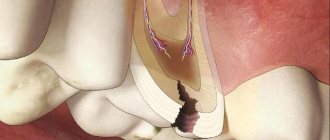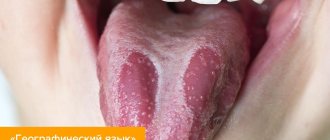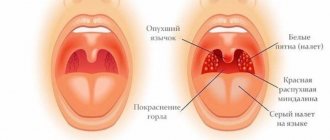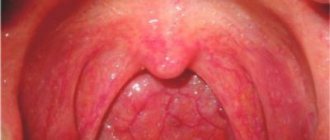What is the larynx?
Many people, even those who know anatomy well, may confuse the larynx with the pharynx, throat, or trachea. The larynx is not a separate organ, but a section of the respiratory system that is especially important and very complex in structure.
The larynx is located in the upper part of the trachea, at the level of 4-6 cervical vertebrae. Its position is ensured by its attachment to the thyrohyoid gland and connection with the hyoid bone. Air passing through the larynx forms vibrations in a person’s vocal cords - from here the human voice is born1.
The structure of the larynx includes a combination of many cartilages (epiglottis, thyroid cartilage, cricoid cartilage and others) with muscle joints and ligaments. Inside, the larynx is covered with a mucous membrane, which is so loved by viruses and various bacterial infections.
Causes of purulent sore throat
The immediate cause of inflammation of the tonsils is the penetration of infectious agents into them - viruses, bacteria, fungi. However, the disease develops mainly against the background of a decrease in the body’s defenses1.
The impetus for the development of tonsillitis can be:
- hypothermia: the disease occurs especially often in the autumn-winter and spring periods1;
- unbalanced diet, leading to hypovitaminosis and weakened immunity3;
- tonsil injuries, for example, from rough food3;
- nervous system disorders3;
- inflammatory diseases of the nose, paranasal sinuses, oral cavity3.
The palatine tonsils are located at the intersection of the respiratory and digestive tracts. Therefore, they can be affected by microbes from the mouth, nose and throat1.
Most often, purulent inflammation of the tonsils is associated with streptococcal infection2. The most severe forms of the disease are caused by beta-hemolytic streptococcus of group A2,3,4. It is found in 15% of adults with purulent tonsillitis and in 20-30% of children2.
Streptococcal infection is contagious. Patients and even those who have recovered from tonsillitis can be a source of infection for healthy people for 10-12 days1.
Streptococcus often leads to rheumatic diseases and damage to internal organs. Therefore, if signs of purulent tonsillitis appear, you should definitely consult a doctor to find out which microorganism caused the inflammation. Today, rapid tests are used to diagnose streptococcal infections, which show results with an accuracy of 99% within 15-20 minutes5.
Viral tonsillitis is usually caused by pathogens of acute respiratory infections:
- adenoviruses;
- influenza and parainfluenza viruses;
- rhinoviruses1,3;
- herpes simplex virus;
- Epstein–Barr virus;
- cytomegalovirus4 and others.
Sore throat is one of the manifestations of measles, scarlet fever, infectious mononucleosis and blood diseases1. Only a specialist can understand the intricacies of the disease.
Up to contents
Causes of laryngeal edema
The mechanics of edema are simple. In the larynx, as a result of one or another effect, there is a sharp or gradual increase in the volume of mucous tissue, which begins to block the lumen of the respiratory tract. In medicine, this condition is called laryngeal stenosis2.
The reasons that can cause swelling of the larynx are extremely varied. It is generally accepted to divide laryngeal edema into two main types - inflammatory and non-inflammatory.
Pathologies and inflammatory diseases that provoke laryngeal edema include:
- Viral and bacterial infections - acute tonsillitis (tonsillitis), chronic tonsillitis, pharyngitis, tracheitis, inflammatory diseases of the oral cavity, abscess and most diseases of the ARVI group.
- Chronic infectious diseases - tuberculosis, syphilis and others.
- Acute infectious diseases - scarlet fever, measles, typhus.
- Vasomotor edema and allergic edema of the larynx. The cause is an allergy familiar to many, which provokes inflammation of the mucous membrane of the larynx. The laryngeal mucosa is very sensitive to the influence of allergens and the reaction in the form of swelling is quite common.
Non-inflammatory causes are no less diverse; these include swelling due to mechanical, chemical (toxic) or thermal effects. Burns from food that is too hot or cold is a common cause, especially in children. Swelling can also be caused by a foreign object in the throat or a piece of food.
In addition to the nature, inflammatory or non-inflammatory, there are two forms of edema - limited and diffuse (spill). With limited swelling, a person may not even be aware of the condition of the larynx, he is not bothered by severe pain and can breathe freely. Diffuse edema is characterized by severe narrowing of the larynx and damage to a large area of mucous tissue; breathing is almost always difficult2.
How to relieve throat swelling at home?
It must be remembered that at the first symptoms of throat swelling, urgent medical attention is needed. The likelihood of rapid development of the condition requires emergency medical intervention to save the patient’s life. In such a situation, the problem of how to relieve throat swelling at home comes down to providing emergency assistance before the ambulance arrives:
- try to calm the patient, as a panic state increases swelling;
- try to provide access to air (unbutton your collar, remove your tie, if possible, increase the humidity of the room);
- if there is absolute confidence in the allergic nature of the swelling of the throat, then give the patient an antihistamine.
Main symptoms of laryngeal edema
Despite the fact that in most cases laryngeal edema itself is a symptom, it is not always possible to detect it promptly. Professional medical diagnostics or special signs characteristic of laryngeal edema3 come to the rescue:
- Severe cough, most often of the “barking” type;
- Hoarseness, loss or severe changes in voice - given that the human voice apparatus is located in the larynx, this is a quite obvious sign;
- Gradual progression of suffocation, breathing becomes difficult.
Laryngeal edema does not always develop slowly and unnoticeably. In rare cases, an emergency condition occurs in which swelling occurs immediately (laryngospasm). In such a case, the symptoms of laryngeal edema will be pronounced:
- The appearance of cyanosis on the face;
- Severe suffocation and oxygen starvation, complete asphyxia is possible.
Additional signs of the development of laryngeal edema may include more general symptoms that are characteristic of many other diseases:
- Temperature increase;
- Feeling of a foreign object in the throat, while the exact position cannot be determined;
- Discomfort and pain in the larynx area, especially when swallowing;
- Intoxication of the body - general weakness, nausea, headaches, muscle pain, etc.;
- Shortness of breath, even at rest.
Swelling of the throat with sore throat
International medical practice classifies inflammation of the tonsils as acute tonsillitis. However, the more familiar name for us “angina” (translated from Latin means “squeeze, strangle”), quite accurately describes the ongoing pathological process. Swelling of the throat during sore throat partially blocks the airways, and the patient begins to choke. This rather serious local complication is accompanied by:
- stridor (difficulty noisy breathing);
- pain when swallowing in the absence of cough;
- swelling of the neck, change in color of the skin of the face (pallor, and then cyanosis).
Diagnosis of laryngeal edema
In most cases, an experienced doctor (otolaryngologist, pulmonologist or even a therapist) can easily diagnose laryngeal edema. A visual examination or laryngoscopy will give an understanding of the condition of the sick person’s larynx. Endoscopy will show the most complete condition of the larynx. With edema, redness is almost always present, as is swelling of the laryngeal mucosa, and the glottis will be noticeably narrower4.
However, it is not recommended to diagnose this condition yourself. A doctor should examine it, since complications or severe forms are possible, in which there is a risk of suffocation, and swelling can directly indicate the development of a dangerous disease.
Complications after a sore throat: where to expect a blow?
First of all, the ENT organs closest to the source of inflammation come under attack, especially vulnerable after suffering from a sore throat. Therefore, the recovery period, which takes place under the supervision of a specialist, will eliminate the development of a number of dangerous diseases:
- lymphadenitis (inflammation of the lymph nodes) can accompany any form of sore throat. In case of suppuration of the lymph nodes, immediate surgical intervention is required;
- Laryngeal edema is a consequence of excessive swelling of the tonsils and can spread further to the vocal cords. Rapidly developing suffocation poses a serious threat to the patient's life;
- Mediastinitis can occur as a result of suppuration of the posterior pharyngeal wall. The inflammatory process affects the deep cervical regions, right up to the mediastinum.
Chronic tonsillitis occurs after severe or frequent recurrences of tonsillitis. Overgrowth of tonsil tissue is treated with medication, although in some cases surgery is required;
Therefore, it is so important to entrust the treatment of sore throat to a qualified doctor who will determine the form of the disease and prescribe antibiotics that are mandatory in the treatment of sore throat.
The course of therapy should be carried out under the supervision of a specialist who can quickly and correctly respond to any changes in the body and prevent the development of irreversible consequences.
During pregnancy, sore throat is especially dangerous. Intoxication of the mother’s body can harm the baby, and in the early stages (up to 12 weeks) there is often a threat of miscarriage.
First aid and treatment of laryngeal edema
If swelling occurs that causes immediate breathing problems, you need to act quickly. Man's main enemy is panic. In this case, in addition to promptly calling doctors, first aid should be provided.
The first step is to free the chest of an adult or child from any load, including clothing. If you are in a panic state, you should try to calm the person down. Next, provide access to fresh air, and, if possible, reduce the ambient temperature. If the cause of swelling is known, for example the effect of a certain allergen, then it should be blocked immediately. Spraying cool water on your face will help relieve the condition5.
Most often, a timely visit to a doctor solves everything, and treatment of laryngeal edema is as effective as possible. Having established the cause of the swelling, the doctor prescribes medications. Depending on the reasons, anti-inflammatory and antiallergic medications (antihistamines) are used. If the cause is a viral or bacterial infection, immunomodulators and antibiotics may be prescribed for the most serious bacterial infection. In case of sharp progression of edema and suffocation, drug therapy is carried out based on antispasmodic and hormonal drugs.
A person with edema should remain completely at rest, eat liquid foods and drink enough water. It is not recommended to talk a lot - you need to minimize all irritating factors. In the most serious cases, surgery may be required.
As you know, disease is easier to prevent. The same applies to laryngeal edema. The most common causes of edema are acute respiratory diseases. Viruses or bacteria enter the mucous membranes of the larynx and begin to act insidiously. Often, this happens due to insufficient strength of local and general immunity.
To maintain local immunity, doctors may prescribe immunostimulating agents. One of these drugs, but with interesting features, is a drug based on bacterial lysates, Imudon®. The effect of the drug is associated with an increase in the number of cells aimed at fighting bacteria and viruses. Imudon® has direct indications for pharyngitis and chronic tonsillitis6.
Imudon® is presented in the form of lozenges with a pleasant taste, which is especially important for children. The drug can be used from three years of age7. This form allows the drug to act at the very site of inflammation and directly influence local immunity.
Instructions
Learn more
Developed with support from Abbott to improve patient health awareness. The information in the material is not a substitute for healthcare advice. Contact your doctor. 1. Babiyak, V. Otorhinolaryngology / V.I. Babiyak, I.B. Vyacheslav // “Peter” - Study guide, manual - 2009 - Volume 2 - P. 13-30. 2. Soldatsky, Yu. Diseases of the larynx / Yu.L. Soldatsky // Pediatric pharmacology - 2008 - No. 2 - Volume 5 - P. 20-25. 3. Trukhan, D. Respiratory diseases. Tutorial. / D.I. Trukhan, I.A. Viktorova // SpetsLit – 2013 – P. 175. 4. Svistushkin, V. Application of contact endoscopy in the diagnosis of diseases of the larynx / V.M. Svistushkin, N.D. Chuchueva // RMJ – 2015 – No. 23 – P.1406-1408. 5. Gurov, A. Local therapy of inflammatory diseases of the pharynx / A.V. Gurov, M.A. Yushkina // RMJ – 2022 – No. 11 – P. 792-796. 6. Luchikhin, L. Efficacy of the drug Imudon® in the treatment of patients with acute and chronic inflammatory diseases of the pharynx / L. A. Luchikhin [et al.] // Bulletin of Otorhinolaryngology - 2001 - No. 3. – pp. 62-64. 7. Instructions for medical use of the drug Imudon® lozenges dated 07/02/2018.
RUS2157722 from 08/19/2020
Differential diagnosis and treatment tactics for acute tonsillitis (tonsillitis) at the present stage
Acute tonsillitis (AT), or tonsillitis, is an acute infectious disease of one or more components of the lymphadenoid pharyngeal ring with primary damage to the parenchyma, lacunar and follicular apparatus of the tonsils. Sore throat can be an independent nosological form, as well as a complication or one of the manifestations of infectious and somatic diseases [1].
The following forms of OT (angina) are distinguished [2]:
- by etiology: streptococcal, staphylococcal, pneumococcal, etc.;
- by localization of the pathological process: palatine tonsils, lateral pharyngeal ridges, nasopharyngeal tonsil, lingual tonsil, lymphoid formations of the posterior pharyngeal wall, lymphoid formations of the larynx;
- according to the nature of the local process: catarrhal, follicular, lacunar, membranous-necrotic;
- by severity: mild, moderate, severe;
- by disease frequency: primary, recurrent;
- along the course: smooth, non-smooth (with complications, with a layer of secondary infection, with exacerbation of chronic diseases).
Catarrhal tonsillitis is an inflammation of the mucous membrane of the tonsils without the formation of plaque on them.
Follicular tonsillitis is a purulent melting of the follicles of the tonsils, while against the background of hyperemic and hypertrophied tonsils, multiple whitish-yellowish, vaguely demarcated, “millet grain”-sized points are observed, which shine through the epithelial cover in the form of rounded yellowish islands 3-4 mm in size. The surface of the tonsils takes on, in Simanovsky’s figurative expression, the appearance of a “starry sky.”
Lacunar tonsillitis - manifested by enlargement and hyperemia of the tonsils, with a purulent coating emanating from the lacunae and spreading over the surface of the tonsils - it consists of detritus, pus - yellow, white-yellow in color, loose consistency, easily removed, rubbed with a spatula, not beyond the tonsils spreads, the surface of the tonsils does not bleed after its removal, and plaque does not renew after removal.
With membranous-necrotic tonsillitis, there is a sharp pain when swallowing, dirty-gray areas of necrotic tissue of the tonsils up to 10-20 mm in size, and slight swelling of the tonsils. When plaque is rejected, a bleeding defect in the tonsil tissue with an uneven surface is formed.
A mild form of OT is manifested by low-grade fever for no more than 2–3 days, slight pain in the throat when swallowing, moderate general weakness, exudative or follicular tonsillitis, an increase of up to 1 cm in the diameter of the submandibular lymph nodes, and their moderate pain.
The moderate form of OT is accompanied by fever of 38.5–39.0 °C for 4–6 days, severe intoxication (weakness, chills, headache, muscle and joint pain, sleep disturbance), severe tonsillitis (pain in the throat when swallowing, a large number of purulent follicles on the tonsils), enlargement of regional lymph nodes up to 2 cm, their severe soreness.
A severe form of OT is characterized by fever above 39.0 °C, severe intoxication, constant sore throat, severe hyperemia of the tonsils spreading to the soft palate, a large amount of pus in the lacunae, regional lymph nodes are enlarged to 3 cm, painful, there may be signs of kidney damage.
Repeated OT is a disease that occurs annually or no later than two years after the previous one, and is characterized by the more frequent formation of tonsillogenic pathology.
OT most often affects children of school age and adolescence. In early childhood (up to 3 years) and over the age of 50 years, the incidence of OT is lower. This is due to age-related imperfections of the lymphoid tissue of the pharynx in children and its age-related involution after 50 years [1].
The main causative agent of sore throat is considered to be group A β-hemolytic streptococcus (GABHS). The incubation period for acute streptococcal tonsillitis ranges from several hours to 2–4 days. Characterized by an acute onset of the disease with an increase in body temperature to 37.5–39 °C, chills, headache, general malaise, sore throat, aggravated by swallowing, arthralgia and myalgia are not uncommon. Children may have nausea, vomiting, and abdominal pain. A detailed clinical picture is observed, as a rule, on the second day from the onset of the disease, when the general symptoms reach their maximum severity. On examination, redness of the palatine arches, uvula and posterior wall of the pharynx is revealed. The tonsils are hyperemic, swollen, often with a yellowish-white purulent coating. The plaque is loose, porous, and can be easily removed with a spatula from the surface of the tonsils, without the formation of a bleeding defect. All patients experience thickening, enlargement and tenderness of the cervical lymph nodes at the level of the angle of the lower jaw. The hemogram is characterized by leukocytosis of 9–12 × 109/l, with a shift in the leukocyte formula to the left, an increase in ESR, sometimes up to 40–50 mm/h, and an increase in the level of C-reactive protein in the blood.
The relevance of streptococcal sore throat is due not only to its wide distribution, but also to the large number of complications. More than 80 complications are known, including: acute rheumatic fever (ARF), post-streptococcal glomerulonephritis, polyarthritis, systemic vasculitis, infectious-allergic myocarditis, otitis media, peritonsillar abscess, etc. [3–5].
However, OT can be of another bacterial etiology (diphtheria, tularemia, syphilitic, tuberculosis) and candidiasis. Various viruses can also cause OT - herpes simplex virus, Eptstein-Barr virus, cytomegalovirus, adenoviruses and enteroviruses.
With age, the etiology of OT undergoes significant changes. According to L.G. Aistova et al. (2012), in children aged 3 months to 3 years, in 44% of cases, OT is caused by multiple mixed herpetic infection, in 31% of cases - by opportunistic microflora (Neisseria perflava), in 35% - by streptococci of different groups (A, F, D). In children aged 3 to 7 years, on the contrary, herpes viruses were detected only in 9% of cases, and in 77% of cases, sore throat was caused by bacterial flora and was not complicated by herpetic infection; streptococci of groups A, F, D were diagnosed in 28% [6 ].
Similar results were obtained by A. Yu. Medvedev et al. (2011). During OT, streptococci of different types were isolated: Streptococcus pneumoniae - in 52%, Streptococcus pyogenes - in 18%, Streptococcus agalactiae - in 2% of patients, staphylococci (Staphylococcus aureus, etc.) - in 18%. In 10% of patients, gram-negative and gram-positive opportunistic bacteria were noted as independent pathogens of OT, and herpes viruses were found in 18% [7].
Due to the wide variety of etiologies of OT, infectious disease specialists and pediatricians face an important task - competent diagnosis and timely prescription of adequate therapy. In modern Russia, 95% of OT patients receive antibiotics, including often doctors at clinics prescribing ineffective drugs: ampicillin (45%), erythromycin (19%), ciprofloxacin (7%), doxycycline (6%), etc. [5]. Not every OT needs to prescribe antibiotics, but they are required for streptococcal sore throat. With the latter, the main goal of antibacterial therapy (ABT) is the eradication of group A streptococcus, since only in this case the risk of developing a complication such as ARF is eliminated.
Unjustified use of antibiotics leads to the development of microbial resistance to them, the development of complications (anaphylactic reactions, intestinal imbalance, the development of fungal complications), and increases the cost of therapy.
To diagnose OT caused by GABHS [2, 8], the following are used:
- clinical differential diagnosis;
- clinical scale method;
- method of cultural studies (microbiological diagnostics);
- express diagnostic method (rapid tests).
However, none of these methods are 100% effective and each has disadvantages.
Considering that no clinical symptom can be absolute proof in identifying streptococcal tonsillitis and the diagnostic significance of various symptoms is not the same, a progressive step was the formalization of symptoms and their reduction into clinical scales. From them, the doctor will know the likelihood of isolating GABHS during a cultural examination of a smear from the oropharynx. The following scales have been developed: Breeze scale (1975), Walsh scale (1977), Sentor scale (1981), MacIsaac scale (1998). The higher the total score for them, the higher the likelihood of isolating GABHS. The predictive power of clinical scales is not high enough (with a maximum MacIsaac score of 51–53%), and therefore, even if the patient has a maximum score, streptococcal tonsillitis cannot be diagnosed with confidence. However, the scales allow us to identify a group of patients with a low risk of streptococcal sore throat. If the Sentor or MacIsaac clinical scale is used, then with a score of 1 point or less, the risk of GABHS isolation does not exceed 10% [8, 9].
The MacIsaac scale for a patient with OT provides [9]:
- body temperature above 38 °C - 1 point;
- absence of cough - 1 point;
- enlargement and tenderness of cervical lymph nodes - 1 point;
- swelling of the tonsils and the presence of exudate - 1 point;
- age from 3 to 14 years - 1 point;
- age from 15 to 44 years - 0 points;
- age over 45 years - 1 point.
Medical tactics for a patient with OT depends on the number of points on the MacIsaac scale and is presented in table. 1.
The gold standard for examining a patient with complaints of sore throat is a bacteriological examination of an oropharyngeal smear [10–12]. The smear collection technique has a significant impact on the sensitivity of the method. A smear is taken using a swab from the surface of the tonsils, from the mouths of the tonsil crypts and from the back wall of the pharynx. You should not touch the swab to other areas of the mucous membrane before and after collecting the material. The swab should not be taken soon after eating. The material cannot be representative if taken after the start of ABT. The sensitivity of the culture method is 90%, specificity 95–99%. The disadvantage of this method is that the answer is received only 1–2 days after collecting the material, as well as the need for a bacteriological laboratory [12]. The desire to avoid these shortcomings led to the development of rapid tests that can detect GABHS directly in an oropharyngeal smear [11, 12]. Comparative characteristics of these tests are given in table. 2.
The sensitivity of the first and second generation tests is not a fixed value and depends on the number of microorganisms in the material and the severity of the clinical picture. The lower the clinical scale score and the lower the amount of GABHS, the less sensitive the system is [12].
Rapid tests complement, but do not replace the cultural method, since a negative rapid diagnostic result does not exclude streptococcal etiology of the disease [13]. In addition, only by isolating the pathogen can its sensitivity to antibiotics be determined, which is an important aspect in working to reduce antibiotic resistance [14]. Rapid testing involves obtaining results “at the patient’s bedside” within 4–10 minutes. The analysis is performed by a physician and does not require a special laboratory, and the sensitivity and specificity of modern second-generation tests, exceeding 90%, make it possible to avoid duplicate bacteriological testing if the rapid test result is negative [15].
K. V. Shpynev et al. (2007) proposed the following algorithm for diagnosis and treatment tactics for OT [3] (Fig.).
Therapy for any etiology includes bed rest for the first 3–4 days of illness, a diet with a predominance of dairy and plant-based foods rich in vitamins, and drinking plenty of fluids. All patients with OT are prescribed pathogenetic and symptomatic therapy with non-steroidal anti-inflammatory drugs (NSAIDs) and antihistamines.
Fever below 38°C in initially healthy children and adults generally does not require treatment. However, with streptococcal sore throat, fever is often combined with manifestations of intoxication, which significantly worsens the well-being of patients.
Antipyretic therapy for OT is indicated [16]:
- previously healthy: - at t > 39 °C; - for muscle aches; - for headaches.
- with a history of convulsions at t > 38 °C.
- for severe chronic diseases (t > 38 °C).
- in the first 3 months of life (t > 38 °C).
Prescribing acetylsalicylic acid (Aspirin) for this purpose to children and adolescents has been prohibited in the United States since the 70s, and in Russia since the late 1990s, due to the proven connection of their use with the development of Reye's syndrome. Analgin is not used as an over-the-counter antipyretic, which is associated with the risk of developing agranulocytosis and collapse with hypothermia; this drug is prescribed only as an analgesic or to quickly reduce temperature for special indications as part of a lytic mixture: IM Analgin 50% solution 0.1–0.2 ml/10 kg + Papaverine 0.1–0.2 ml 2% solution . Paracetamol is a frequently used antipyretic and mild analgesic in children, a derivative of phenacetin, but much less toxic than the latter. Contraindicated for liver diseases. Ibuprofen (Nurofen for children, Nurofen) - a derivative of propionic acid - has antipyretic, analgesic and anti-inflammatory properties. Currently used in more than 30 countries [16].
The safety of Nurofen for children is due to:
- short half-life (1.8–2 hours);
- during metabolism in the liver, pharmacologically active substances are not formed, so there is no direct toxic effect on parenchymal organs (liver, kidneys, etc.);
- excretion of drug metabolites in urine is completed 24 hours after taking the last dose. The rapid metabolism and excretion of ibuprofen to some extent explain its relatively low toxicity compared to other NSAIDs and the lack of negative effects on renal function. With long-term use, its accumulation in the body does not occur.
If there is a history of allergic diseases and concomitant pathology of the digestive organs, it is rational to use paracetamol or Nurofen in suppositories due to the absence of flavoring additives in the rectal form and a direct effect on the gastric mucosa [16].
Local treatment includes gargling with solutions containing antiseptic or anti-inflammatory agents to mechanically remove debris from the tonsils. It is of leading importance compared to irrigating the throat with aerosols. The most effective aerosol today is Miramistin. Symptomatic and local therapy for acute tonsillitis shortens the course of the disease by one day, which does not mean that it should be neglected.
Drugs recommended for local treatment of OT:
- chlorophyllipt - 1 tsp must be dissolved in 100 ml of water;
- tea tree essential oil - essential oils do not dissolve in water, so 4-5 drops of oil must first be dropped into a teaspoon of salt or soda, and then stirred in warm water (1 glass);
- Miramistin 3-4 times pressing 3-4 times a day. The amount of the drug per irrigation is 10–15 ml.
Rinse solutions should be as fresh and warm as possible. Rinsing should be done at least 3 times a day, especially after meals. After the procedure, you should not eat or drink for 20–30 minutes. One rinse should last at least 30 seconds.
Systemic ABT is aimed at eradicating the main causative agent of angina - GABHS [17]. When choosing ABT, it should be taken into account that GABHS are highly sensitive to penicillins and cephalosporins. The route of administration for systemic ABT should provide the necessary concentration of the drug at the site of infection, be simple and not burdensome for the child. For outpatients, antibiotics are usually prescribed orally, except in cases where one intramuscular injection is sufficient. In the hospital, the antibiotic is often administered intramuscularly (in the absence of blood clotting disorders), and in severe forms and the possibility of venous catheterization - intravenously. Parenteral administration of antibiotics should be used at the beginning of treatment, and when the patient’s condition improves, it is advisable to switch to taking the drug orally. In pediatrics, this provision is especially important for reducing negative reactions on the part of the child.
The first-line drugs in the treatment of infectious processes caused by streptococcus pyogenes, both in Russia and abroad, are semi-synthetic penicillins [8, 18, 19]. Beta-lactams remain the only class of antibiotics to which GABHS has not developed resistance [4, 8]. At the same time, resistance to tetracyclines and sulfonamides in Russia exceeds 60%. In addition, tetracyclines, sulfonamides, co-trimoxazole do not provide eradication of GABHS, and therefore they should not be used for the treatment of acute streptococcal tonsillitis caused even by strains sensitive to them in vitro [18]. Macrolide antibiotics, due to the rapid increase in streptococcal resistance to them, are third-line drugs for the treatment of acute tonsillitis [20].
To eradicate GABHS, a 10-day course of ABT is required (the exception is azithromycin, which is used for 5 days). Early administration of antibiotics significantly reduces the duration and severity of symptoms of the disease. Repeated microbiological examination at the end of ABT is indicated for children with a history of rheumatic fever, in the presence of streptococcal tonsillitis in organized groups, as well as in cases of high incidence of rheumatic fever in a particular region [14].
The choice of drug for ABT of streptococcal OT is reflected in table. 3.
The clinical effect of penicillins is assessed at the turn of 48-72 hours of therapy, macrolides (azalides) - 48-56 hours.
A review of the initial ABT is carried out when:
- absence of clinical signs of improvement within 48–72 hours (depending on the type of antibiotic) from the start of therapy;
- at an earlier time as the severity of the disease increases;
- with the development of severe adverse reactions;
- when clarifying the causative agent of infection and its sensitivity to antibiotics based on the results of a microbiological study.
If natural penicillins are ineffective and with recurrent streptococcal tonsillitis, other antibacterial drugs are prescribed orally for 10 days: amoxicillin/clavunate, cefuroxime axetil, clindamycin, lincomycin [14, 17, 18].
Errors in the treatment of streptococcal tonsillitis include [14, 18]:
- incorrect differential diagnosis of streptococcal, viral and tonsillitis of other etiologies;
- neglect of the combination of analytical methods (clinical, scale method, microbiological studies);
- unreasonable preference for local treatment (rinsing, etc.) to the detriment of systemic ABT;
- underestimation of the clinical and microbiological effectiveness and safety of penicillins;
- prescription of sulfonamides, co-trimoxazole, tetracycline, fusidine, aminoglycosides;
- reduction of the ABT course with clinical improvement.
Acute tonsillitis of another etiology may have similar symptoms. Differential diagnosis of tonsillitis is carried out during pharyngoscopy based on the predominance of certain changes in the tonsils, as well as taking into account other changes in the pharynx and general manifestations of the disease, including symptoms characteristic of certain infectious diseases.
The most dangerous disease accompanied by OT is diphtheria. Diphtheria can occur in localized and toxic forms. The localized form of oropharyngeal diphtheria is characterized by an acute or subacute onset, chilling, increased body temperature up to 38 °C, headache, weakness - signs of moderate intoxication. A sore throat may not appear immediately; it is not very severe. Plaque on the tonsils forms already in the first hours, and by the end of the first day (beginning of the second day) a dense film with a smooth surface of a grayish-white, pearlescent color is formed. Around the plaque there is a faint hyperemia of the mucous membrane with a cyanotic tint. In the early stages, the film can be removed without damaging the mucous membrane. Subsequently, the plaque becomes denser, thickens, and when you try to remove it, the mucous membrane bleeds. In areas where plaque has been removed, it forms again. The plaque rises above the surface of the tonsils, its edge is clearly demarcated from healthy tissue. Swelling of the tonsils corresponds to the intensity of plaque formation. The reaction of the lymph nodes is moderate. The period of elevated body temperature with localized diphtheria lasts 3 days. With normalization of temperature, sore throat decreases, but plaque on the tonsils persists for 6–7 days [21].
Toxic diphtheria of the oropharynx begins acutely, with chills, headache, nausea, and severe sore throat. Body temperature rises to 39–40 °C. Fibrinous deposits in toxic diphtheria are detected in the first hours of the disease. From the second day they become denser and spread beyond the tonsils. An early sign of toxic diphtheria is swelling of the mucous membrane of the oropharynx, which spreads from the tonsils to the soft palate, arches, and uvula. The relief of the tonsils is smoothed out, and they merge with the tissue of the arches, closing with the internal surfaces. The swelling does not have clear boundaries, grows quickly, the tonsils acquire a purplish-bluish tint; hyperemia can be bright. There is severe pain when swallowing, difficulty in eating any food, pain in the neck, and a sweetish-sweet odor emanates from the mouth. From the first day of illness, there is a significant increase in lymph nodes; they are dense and painful [21].
Swelling of the subcutaneous tissue of the neck is detected from the second day of illness. It has a doughy consistency, painless, and spreads from the regional lymph nodes to the neck. The spread of edema of the tissue serves as a criterion for assessing the severity of toxic diphtheria of the oropharynx: if the edema is localized only above the regional lymph nodes, they speak of a subtoxic form, if the lower border reaches the 1st cervical fold - of the toxic form of the 1st degree, up to the clavicles - 2nd degree, below the clavicles — III.
Simanovsky–Plaut–Vincent angina accounts for 5–8% of all angina. It is caused by the association of two microorganisms: Borrelii vincenti and the fusiform bacillus - Fusobacterii fusiforme hoffman, and is characterized by the absence of severe intoxication. Body temperature does not rise above subfebrile values. Sore throat is mild. The process is often one-sided, manifested by a grayish coating followed by the formation of a crater-shaped ulcer and a putrid odor from the mouth.
Candidomycosis is also practically not accompanied by general symptoms; it often develops against the background of HIV infection or other immunodeficiencies. The plaque resembles a cheesy mass; after removing the plaque, the mucous membrane does not bleed. Plaques can merge and spread to the soft palate and the back of the pharynx. Cervical lymphadenitis is not typical [1].
Herpangina is more common in children under 15 years of age. The causative agent is considered to be Coxsackievirus type A. This form of tonsillitis is accompanied by severe symptoms of intoxication and high fever. Vesicles with serous contents are visible on the anterior palatine arches; the palatine tonsils themselves may be only slightly hyperemic, but in some cases they are covered with small white blisters or ulcerations [1].
Infectious mononucleosis caused by the Epstein-Barr virus is characterized by severe malaise, fever up to 38–39 °C, sore throat, hepatosplenomegaly, enlargement of the superficial and deep lymph nodes of the neck, snoring, nasal congestion, and later a reaction appears in other groups of lymph nodes. The timing of the appearance of tonsillitis lags behind other signs of infectious mononucleosis. Plaques on the tonsils are white or white-yellow in color and are difficult to separate. In the hemogram, the initial leukopenia is replaced by pronounced leukocytosis (up to 20–30 × 109/l); in the leukocyte formula, up to 80–90% are lymphocytes, monocytes and atypical mononuclear cells. In infectious mononucleosis, drugs from the aminopenicillin group (ampicillin, amoxicillin (Flemoxin Solutab), amoxicillin with clavulanate (Amoxiclav, Moxiclav, Augmentin)) are contraindicated due to the possibility of developing an allergic reaction in the form of exanthema 5–7 days after the start of administration.
Peritonsillar abscess is a complication of chronic tonsillitis and develops following its exacerbation. It is characterized by high fever and severe intoxication. The sore throat is sharp, increasing in intensity as the disease progresses. Due to pain, the patient cannot swallow food, water, or saliva. Characterized by a forced position of the head with a tilt to the side, trismus of the masticatory muscles (during the formation of an abscess). Hyperemia of the pharynx is bright, there may be plaques that can be easily removed and rubbed. There is no correspondence between the prevalence of plaque and edema - an increase in edema is not accompanied by the transfer of plaque from the tonsils to the soft palate; there may be no plaque at all. Swelling and infiltration are one-sided, pronounced, and there is an overhang of the pharynx vault. Hypersalivation is characteristic.
Medical tactics for tonsillitis caused by these etiological agents include timely referral of the patient to an infectious diseases hospital for laboratory examination and treatment in accordance with the etiology of the disease.
Literature
- Kochetkov P. A., Lopatin A. S. Sore throat and acute pharyngitis // Atmosphere. Pulmonology. Allergology. 2005; 3:8–14.
- Clinical recommendations (treatment protocol) for providing medical care to children with tonsillitis (acute streptococcal tonsillitis). FSBI NIIDI FMBA of Russia, 2015. 29 p.
- Sipyagina M.K., Zorkina A.V. Dynamics of some echocardiographic indicators in recurrent tonsillitis // Bulletin of RUDN University. 2010; 1:88–91.
- Walker MJ, Barnett TC, McArthur JD, Cole JN, Gillen CM, Henningham A., Sriprakash KS, Sanderson-Smith ML, Nizet V. Disease manifestations and pathogenic mechanisms of Group A Streptococcus // Clin Microbiol Rev. 2014; 27(2):264–301.
- Anjos LM, Marcondes MB, Lima MF, Mondelli AL, Okoshi MP Streptococcal acute pharyngitis // Rev Soc Bras Med Trop. 2014; 47(4):409–413.
- Aistova L.G., Silchuk N.V., Polovitsa N.V. Mixed herpetic infection in sore throats in children // Far Eastern Journal of Infectious Pathology. 2012; 21: 60–62.
- Medvedev A. Yu., Valishin D. A. Etiological features of tonsillitis in patients infected with the Epstein-Barr virus // Medical Bulletin of Bashkortostan. 2011; 3:88–90.
- Regoli M., Chiappini E., Bonsignori F., Galli L., de Martino M. Update on the management of acute pharyngitis in children // Ital J Pediatr. 2011; 37:10.
- Mclsaac W.J., Goel V., To T. et al. The validity of sore throat score in family practice // CMAJ. 2000; 163(7):811815.
- Gerber MA, Baltimore RS, Eaton CB, Gewitz M., Rowley AH, Shulman ST, Taubert KA Prevention of rheumatic fever and diagnosis and treatment of acute Streptococcal pharyngitis: a scientific statement from the American Heart Association endorsed by the American Academy of Pediatrics Circulation . 2009, 119: 1541–1551.
- Choby BA Diagnosis and treatment of streptococcal pharyngitis // Am Fam Physician. 2009; 79(5):383–390.
- Sokolov N. S., Otvagin I. V. Approaches to the etiological diagnosis of acute tonsilopharyngitis in the practice of an otolaryngologist // Bulletin of the Smolensk State Medical Academy. 2016; 15 (3): 57–61.
- American Academy of Pediatrics, Committee on Infectious Diseases: Red Book: Report of the Committee on Infectious Diseases. Elk. Grove Village, 2006. 27 p.
- Nanosova V. A., Belov B. S., Strachunsky L. S. et al. Antibacterial therapy of streptococcal tonsillitis and pharyngitis // Clinical microbiology and antimicrobial chemotherapy. 1999; 1: 78–82.
- Tonsillopharyngitis / Ed. Ryazantseva S.V. St. Petersburg: Polyforum. Flu. 2014. 40 p.
- Krasnova E.I. Acute streptococcal infection. Clinical, diagnostic, treatment and prophylactic aspects. Novosibirsk 2015. 160 p.
- Kryuchko T. A., Tkachenko O. Ya., Specht T. V. The problem of tonsillitis in pediatric practice // Modern Pediatrics. 2012; 2 (42): 41–46.
- Handbook of antimicrobial therapy. Issue 2 / Ed. R. S. Kozlova, A. V. Dekhnicha. Smolensk: MAKMAH, 2010. 416 p.
- Brook I. Treatment challenges of group A beta-hemolytic Streptococcal pharyngo-tonsillitis // Int Arch Otorhinolaryngol. 2017; 21(3):286–296.
- Tulupov D. A., Karpova E. P. Antibacterial therapy of acute infections of the upper respiratory tract in children // Medical Council. 2018; 11:58–63.
- Bacterial diseases: textbook / Ed. N. D. Yushchuk. M.: GEOTAR-Media, 2014. 976 p.
E. I. Krasnova1, Doctor of Medical Sciences, Professor N. I. Khokhlova, Candidate of Medical Sciences V. V. Provorova, Candidate of Medical Sciences A. N. Evstropov, Doctor of Medical Sciences, Professor
Federal State Budgetary Educational Institution of Higher Education NSMU Ministry of Health of the Russian Federation, Novosibirsk
1 Contact information: [email protected] ru
Differential diagnosis and therapeutic tactics for acute tonsillitis (tonsillitis) at the present stage / E. I. Krasnova, N. I. Khokhlova, V. P. Provorova, A. N. Evstropov For citation: Attending physician No. 11/2018; Page numbers in issue: 58-63 Tags: infections, differential diagnosis, β-hemolytic streptococcus
General recommendations
Rest, adequate fluid intake, gentle nutrition, it is advisable to avoid irritation of the respiratory tract. Most patients can return to work or school after completing one full day of treatment, provided their general health allows it.
The recommendation is based on a small cohort study in children that showed that about 80% of patients with culture-proven streptococcal pharyngitis were no longer infectious within 24 hours of starting therapy.
A follow-up rapid test for streptococcus after treatment is usually not required and is indicated only in the following cases:
- patients with a history of acute rheumatic fever;
- patients who became ill during an outbreak of acute rheumatic fever or post-streptococcal glomerulonephritis;
- patients who became infected from close relatives (in the family).
If the control test is positive, it is recommended to repeat the 10-day course of antibiotic therapy. For the second course of treatment, an antibiotic is selected that is more stable against beta-lactamase degradation.
How long does a sore throat last?
The duration of the disease depends on its form and severity. The total duration usually does not exceed 7 days4.
Regardless of how long a purulent sore throat is treated, the doctor states recovery only 5 days after the temperature normalizes. In this case, the patient’s sore throat should disappear, and the lymph nodes should become painless. In addition, the results of blood tests, urine tests and electrocardiograms are always taken into account3.
Up to contents
Complication of the disease
Sore throat is dangerous because of its complications, which can be early, i.e. occurring immediately after inflammation of the tonsils or delayed, which appear 3-4 weeks after purulent inflammation. Complications can be single (affect one organ) or multiple and affect several organs.
Early complications of tonsillitis are otitis media, lymphadenitis, sinusitis, sinusitis, laryngeal edema, tonsil abscess, etc. Delayed inflammation provokes diseases of the heart muscle (rheumatism of the heart muscle, myocarditis, pericarditis), joint pathologies (rheumatism, arthritis), kidney diseases (glomerumetritis, pyelonephritis, renal failure).
In medical clinics, at any time convenient for you, they will provide timely and qualified assistance for any diseases of the ENT organs in patients of all age categories. The clinics are equipped with modern diagnostic equipment for diagnosing ENT diseases, and patients also have a modern diagnostic laboratory at their disposal, in which all necessary laboratory tests are performed.
Our otorhinolaryngology doctors have extensive experience in diagnosing and treating various diseases of the ear, nose and throat in adults and children, using both conservative and surgical methods. When the first symptoms of a sore throat or other pathologies appear, do not delay visiting a doctor and seek qualified medical help. You can make an appointment by calling the center or leaving a request on the website.
Forms of the disease in children
All types of acute tonsillitis occur in children, but their prevalence depends on age.
Sore throat in a child 1-3 years of age is more likely (44% of cases) associated with a herpetic infection2. Only 35% of cases of the disease are the result of the activity of streptococci2.
In children aged 3 to 7 years, tonsillitis is more often bacterial, but streptococci are found only in 28% of cases2. Further, the picture changes towards the predominance of streptococcal infection and in adolescents it already accounts for up to 52% of cases of inflammation.
According to the picture of pathological changes in the tonsils1, inflammation of the tonsils can be:
- Erythematous (catarrhal), accompanied by redness of the tonsils and palatine arches. Viral tonsillitis, streptococcal (in the initial stages of development) or atypical, caused by Yersinia, mycoplasma, chlamydia, have such a clinical picture.
- Vesicular, characterized by the appearance of vesicles with turbid liquid on the tonsils, after opening of which small erosions form on the mucous membrane. This is how herpetic sore throats, tonsillitis with measles, and chickenpox occur.
- Membranous, in which purulent or necrotic films appear on the tonsils1. In lacunar forms, the film forms pus flowing from the lacunae, which is easily removed with a swab2. True films in diphtheria are firmly connected to the underlying tissue of the tonsils2.
According to the severity of the course, acute tonsillitis in children can be:
- light,
- moderate severity,
- heavy.
With the flow:
- without complications,
- with complications.
Up to contents










